Assessing Communication and Culture at Babcock International: A Report
VerifiedAdded on 2023/03/24
|12
|3873
|51
Report
AI Summary
This report, focusing on Babcock International, a UK-based global support services company, analyzes the challenges of managing communication and cultural differences when expanding operations into Brazil. The study explores various communication and cultural models, including linear, interactive, power, role, task, and person cultures, highlighting their impact on high-performance working practices. The report examines the issues arising from language barriers and differing management styles between UK and Brazilian workers. The methodology emphasizes the importance of non-verbal and interactive communication models, as well as a culture model that prioritizes organizational goals. The findings underscore the need for Babcock International to adapt its communication processes and cultural practices to accommodate its Brazilian workforce effectively, recommending strategic changes and awareness programs to foster better integration and improve overall performance. The report concludes by emphasizing the importance of proactive planning and adaptation for successful international business operations.
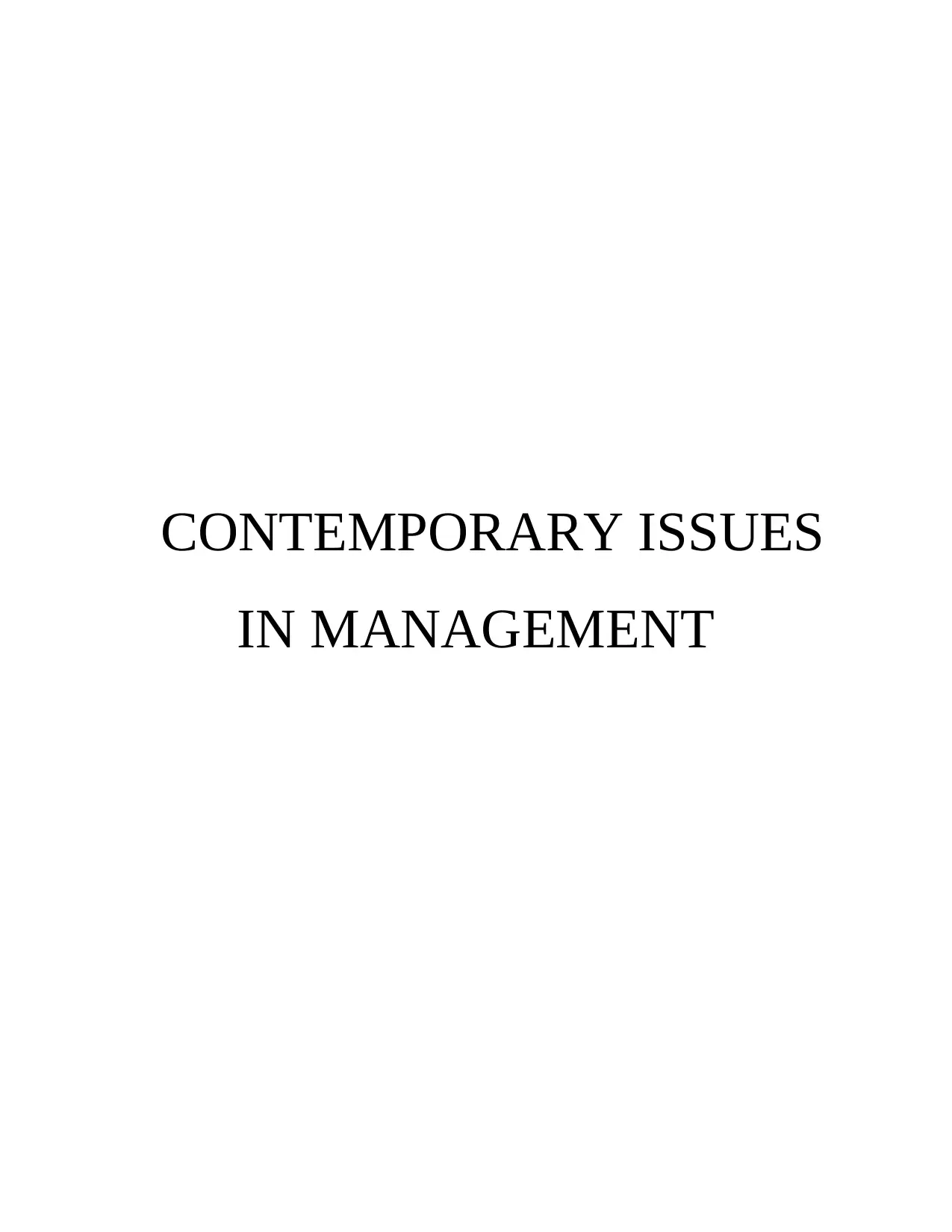
CONTEMPORARY ISSUES
IN MANAGEMENT
IN MANAGEMENT
Paraphrase This Document
Need a fresh take? Get an instant paraphrase of this document with our AI Paraphraser
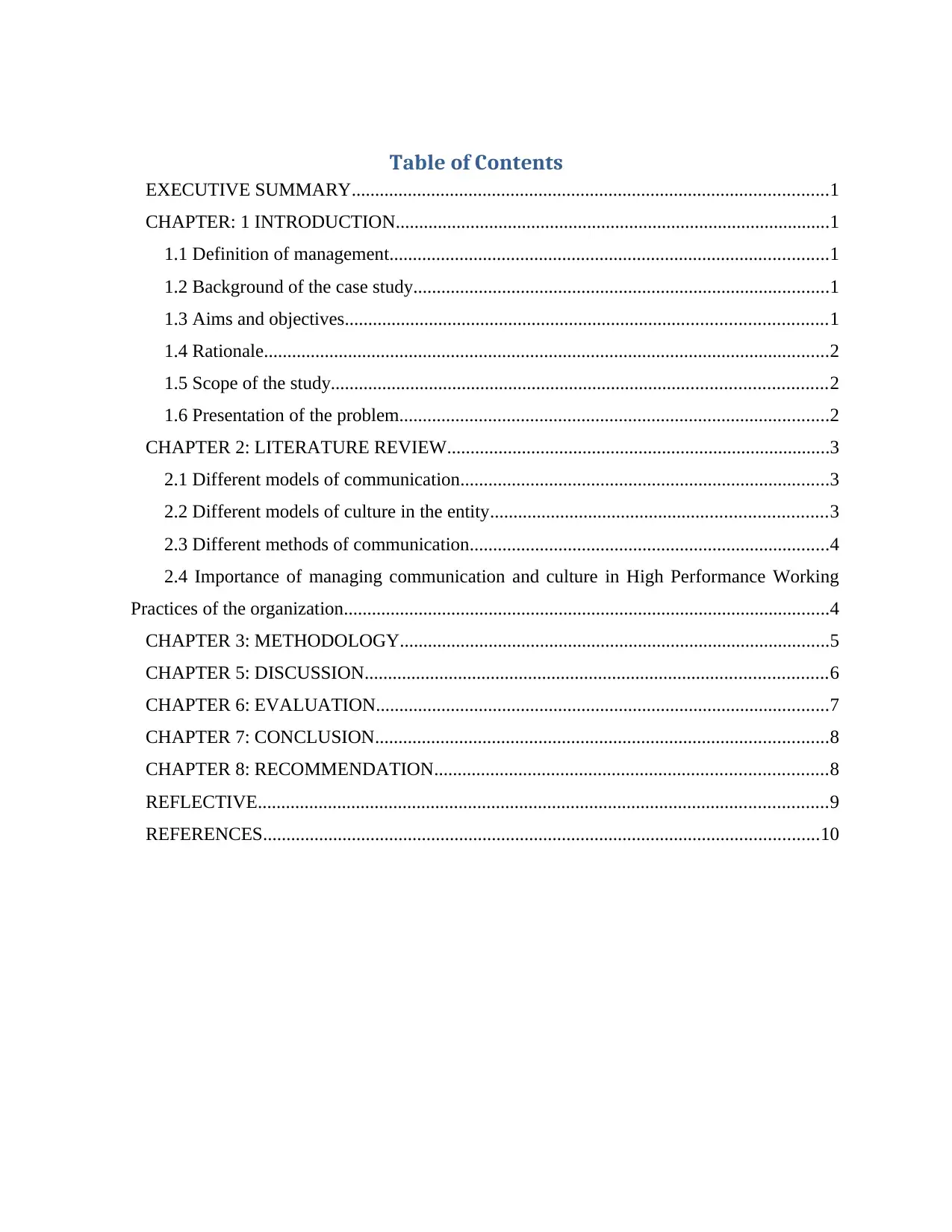
Table of Contents
EXECUTIVE SUMMARY......................................................................................................1
CHAPTER: 1 INTRODUCTION.............................................................................................1
1.1 Definition of management..............................................................................................1
1.2 Background of the case study.........................................................................................1
1.3 Aims and objectives.......................................................................................................1
1.4 Rationale.........................................................................................................................2
1.5 Scope of the study..........................................................................................................2
1.6 Presentation of the problem............................................................................................2
CHAPTER 2: LITERATURE REVIEW..................................................................................3
2.1 Different models of communication...............................................................................3
2.2 Different models of culture in the entity........................................................................3
2.3 Different methods of communication.............................................................................4
2.4 Importance of managing communication and culture in High Performance Working
Practices of the organization........................................................................................................4
CHAPTER 3: METHODOLOGY............................................................................................5
CHAPTER 5: DISCUSSION...................................................................................................6
CHAPTER 6: EVALUATION.................................................................................................7
CHAPTER 7: CONCLUSION.................................................................................................8
CHAPTER 8: RECOMMENDATION....................................................................................8
REFLECTIVE..........................................................................................................................9
REFERENCES.......................................................................................................................10
EXECUTIVE SUMMARY......................................................................................................1
CHAPTER: 1 INTRODUCTION.............................................................................................1
1.1 Definition of management..............................................................................................1
1.2 Background of the case study.........................................................................................1
1.3 Aims and objectives.......................................................................................................1
1.4 Rationale.........................................................................................................................2
1.5 Scope of the study..........................................................................................................2
1.6 Presentation of the problem............................................................................................2
CHAPTER 2: LITERATURE REVIEW..................................................................................3
2.1 Different models of communication...............................................................................3
2.2 Different models of culture in the entity........................................................................3
2.3 Different methods of communication.............................................................................4
2.4 Importance of managing communication and culture in High Performance Working
Practices of the organization........................................................................................................4
CHAPTER 3: METHODOLOGY............................................................................................5
CHAPTER 5: DISCUSSION...................................................................................................6
CHAPTER 6: EVALUATION.................................................................................................7
CHAPTER 7: CONCLUSION.................................................................................................8
CHAPTER 8: RECOMMENDATION....................................................................................8
REFLECTIVE..........................................................................................................................9
REFERENCES.......................................................................................................................10
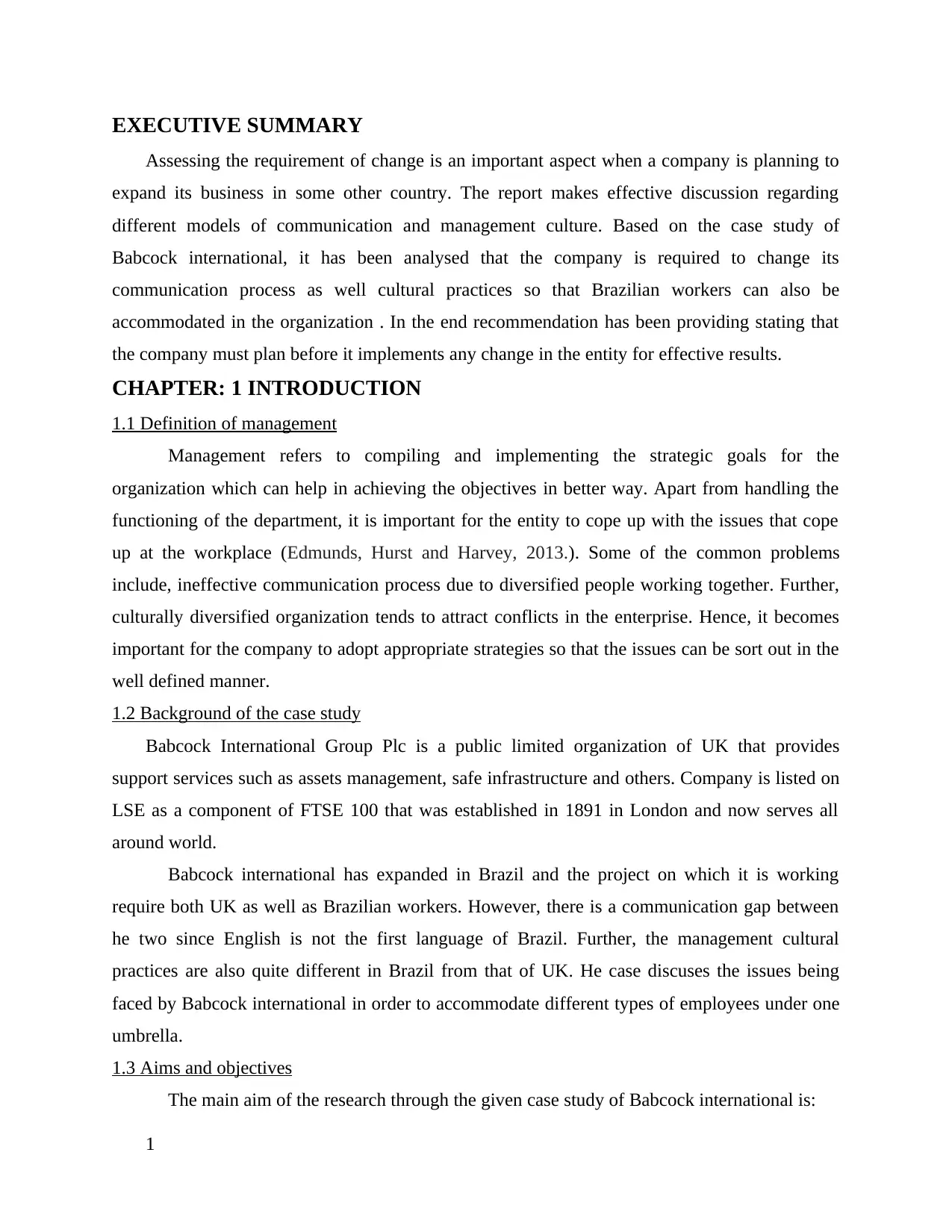
EXECUTIVE SUMMARY
Assessing the requirement of change is an important aspect when a company is planning to
expand its business in some other country. The report makes effective discussion regarding
different models of communication and management culture. Based on the case study of
Babcock international, it has been analysed that the company is required to change its
communication process as well cultural practices so that Brazilian workers can also be
accommodated in the organization . In the end recommendation has been providing stating that
the company must plan before it implements any change in the entity for effective results.
CHAPTER: 1 INTRODUCTION
1.1 Definition of management
Management refers to compiling and implementing the strategic goals for the
organization which can help in achieving the objectives in better way. Apart from handling the
functioning of the department, it is important for the entity to cope up with the issues that cope
up at the workplace (Edmunds, Hurst and Harvey, 2013.). Some of the common problems
include, ineffective communication process due to diversified people working together. Further,
culturally diversified organization tends to attract conflicts in the enterprise. Hence, it becomes
important for the company to adopt appropriate strategies so that the issues can be sort out in the
well defined manner.
1.2 Background of the case study
Babcock International Group Plc is a public limited organization of UK that provides
support services such as assets management, safe infrastructure and others. Company is listed on
LSE as a component of FTSE 100 that was established in 1891 in London and now serves all
around world.
Babcock international has expanded in Brazil and the project on which it is working
require both UK as well as Brazilian workers. However, there is a communication gap between
he two since English is not the first language of Brazil. Further, the management cultural
practices are also quite different in Brazil from that of UK. He case discuses the issues being
faced by Babcock international in order to accommodate different types of employees under one
umbrella.
1.3 Aims and objectives
The main aim of the research through the given case study of Babcock international is:
1
Assessing the requirement of change is an important aspect when a company is planning to
expand its business in some other country. The report makes effective discussion regarding
different models of communication and management culture. Based on the case study of
Babcock international, it has been analysed that the company is required to change its
communication process as well cultural practices so that Brazilian workers can also be
accommodated in the organization . In the end recommendation has been providing stating that
the company must plan before it implements any change in the entity for effective results.
CHAPTER: 1 INTRODUCTION
1.1 Definition of management
Management refers to compiling and implementing the strategic goals for the
organization which can help in achieving the objectives in better way. Apart from handling the
functioning of the department, it is important for the entity to cope up with the issues that cope
up at the workplace (Edmunds, Hurst and Harvey, 2013.). Some of the common problems
include, ineffective communication process due to diversified people working together. Further,
culturally diversified organization tends to attract conflicts in the enterprise. Hence, it becomes
important for the company to adopt appropriate strategies so that the issues can be sort out in the
well defined manner.
1.2 Background of the case study
Babcock International Group Plc is a public limited organization of UK that provides
support services such as assets management, safe infrastructure and others. Company is listed on
LSE as a component of FTSE 100 that was established in 1891 in London and now serves all
around world.
Babcock international has expanded in Brazil and the project on which it is working
require both UK as well as Brazilian workers. However, there is a communication gap between
he two since English is not the first language of Brazil. Further, the management cultural
practices are also quite different in Brazil from that of UK. He case discuses the issues being
faced by Babcock international in order to accommodate different types of employees under one
umbrella.
1.3 Aims and objectives
The main aim of the research through the given case study of Babcock international is:
1
⊘ This is a preview!⊘
Do you want full access?
Subscribe today to unlock all pages.

Trusted by 1+ million students worldwide
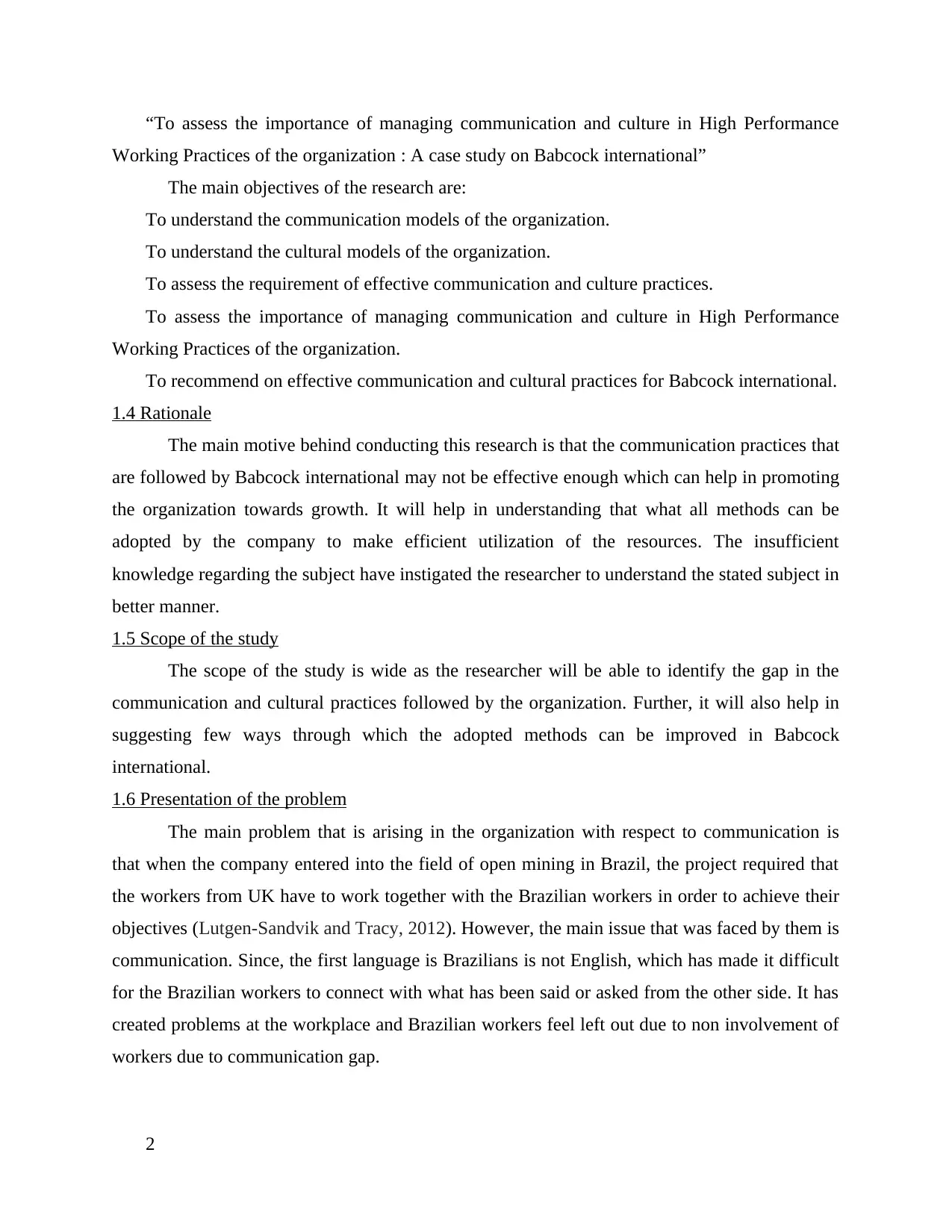
“To assess the importance of managing communication and culture in High Performance
Working Practices of the organization : A case study on Babcock international”
The main objectives of the research are:
To understand the communication models of the organization.
To understand the cultural models of the organization.
To assess the requirement of effective communication and culture practices.
To assess the importance of managing communication and culture in High Performance
Working Practices of the organization.
To recommend on effective communication and cultural practices for Babcock international.
1.4 Rationale
The main motive behind conducting this research is that the communication practices that
are followed by Babcock international may not be effective enough which can help in promoting
the organization towards growth. It will help in understanding that what all methods can be
adopted by the company to make efficient utilization of the resources. The insufficient
knowledge regarding the subject have instigated the researcher to understand the stated subject in
better manner.
1.5 Scope of the study
The scope of the study is wide as the researcher will be able to identify the gap in the
communication and cultural practices followed by the organization. Further, it will also help in
suggesting few ways through which the adopted methods can be improved in Babcock
international.
1.6 Presentation of the problem
The main problem that is arising in the organization with respect to communication is
that when the company entered into the field of open mining in Brazil, the project required that
the workers from UK have to work together with the Brazilian workers in order to achieve their
objectives (Lutgen-Sandvik and Tracy, 2012). However, the main issue that was faced by them is
communication. Since, the first language is Brazilians is not English, which has made it difficult
for the Brazilian workers to connect with what has been said or asked from the other side. It has
created problems at the workplace and Brazilian workers feel left out due to non involvement of
workers due to communication gap.
2
Working Practices of the organization : A case study on Babcock international”
The main objectives of the research are:
To understand the communication models of the organization.
To understand the cultural models of the organization.
To assess the requirement of effective communication and culture practices.
To assess the importance of managing communication and culture in High Performance
Working Practices of the organization.
To recommend on effective communication and cultural practices for Babcock international.
1.4 Rationale
The main motive behind conducting this research is that the communication practices that
are followed by Babcock international may not be effective enough which can help in promoting
the organization towards growth. It will help in understanding that what all methods can be
adopted by the company to make efficient utilization of the resources. The insufficient
knowledge regarding the subject have instigated the researcher to understand the stated subject in
better manner.
1.5 Scope of the study
The scope of the study is wide as the researcher will be able to identify the gap in the
communication and cultural practices followed by the organization. Further, it will also help in
suggesting few ways through which the adopted methods can be improved in Babcock
international.
1.6 Presentation of the problem
The main problem that is arising in the organization with respect to communication is
that when the company entered into the field of open mining in Brazil, the project required that
the workers from UK have to work together with the Brazilian workers in order to achieve their
objectives (Lutgen-Sandvik and Tracy, 2012). However, the main issue that was faced by them is
communication. Since, the first language is Brazilians is not English, which has made it difficult
for the Brazilian workers to connect with what has been said or asked from the other side. It has
created problems at the workplace and Brazilian workers feel left out due to non involvement of
workers due to communication gap.
2
Paraphrase This Document
Need a fresh take? Get an instant paraphrase of this document with our AI Paraphraser
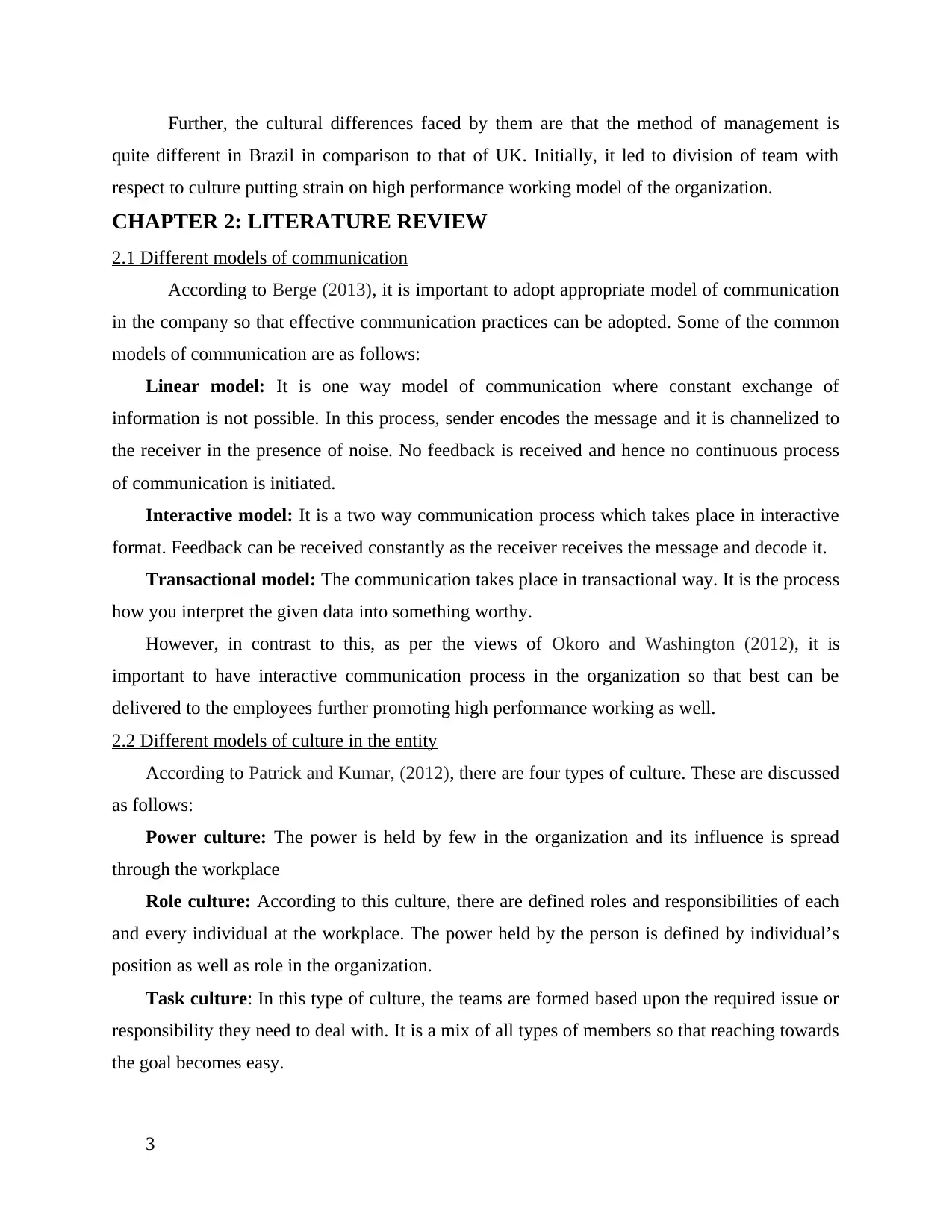
Further, the cultural differences faced by them are that the method of management is
quite different in Brazil in comparison to that of UK. Initially, it led to division of team with
respect to culture putting strain on high performance working model of the organization.
CHAPTER 2: LITERATURE REVIEW
2.1 Different models of communication
According to Berge (2013), it is important to adopt appropriate model of communication
in the company so that effective communication practices can be adopted. Some of the common
models of communication are as follows:
Linear model: It is one way model of communication where constant exchange of
information is not possible. In this process, sender encodes the message and it is channelized to
the receiver in the presence of noise. No feedback is received and hence no continuous process
of communication is initiated.
Interactive model: It is a two way communication process which takes place in interactive
format. Feedback can be received constantly as the receiver receives the message and decode it.
Transactional model: The communication takes place in transactional way. It is the process
how you interpret the given data into something worthy.
However, in contrast to this, as per the views of Okoro and Washington (2012), it is
important to have interactive communication process in the organization so that best can be
delivered to the employees further promoting high performance working as well.
2.2 Different models of culture in the entity
According to Patrick and Kumar, (2012), there are four types of culture. These are discussed
as follows:
Power culture: The power is held by few in the organization and its influence is spread
through the workplace
Role culture: According to this culture, there are defined roles and responsibilities of each
and every individual at the workplace. The power held by the person is defined by individual’s
position as well as role in the organization.
Task culture: In this type of culture, the teams are formed based upon the required issue or
responsibility they need to deal with. It is a mix of all types of members so that reaching towards
the goal becomes easy.
3
quite different in Brazil in comparison to that of UK. Initially, it led to division of team with
respect to culture putting strain on high performance working model of the organization.
CHAPTER 2: LITERATURE REVIEW
2.1 Different models of communication
According to Berge (2013), it is important to adopt appropriate model of communication
in the company so that effective communication practices can be adopted. Some of the common
models of communication are as follows:
Linear model: It is one way model of communication where constant exchange of
information is not possible. In this process, sender encodes the message and it is channelized to
the receiver in the presence of noise. No feedback is received and hence no continuous process
of communication is initiated.
Interactive model: It is a two way communication process which takes place in interactive
format. Feedback can be received constantly as the receiver receives the message and decode it.
Transactional model: The communication takes place in transactional way. It is the process
how you interpret the given data into something worthy.
However, in contrast to this, as per the views of Okoro and Washington (2012), it is
important to have interactive communication process in the organization so that best can be
delivered to the employees further promoting high performance working as well.
2.2 Different models of culture in the entity
According to Patrick and Kumar, (2012), there are four types of culture. These are discussed
as follows:
Power culture: The power is held by few in the organization and its influence is spread
through the workplace
Role culture: According to this culture, there are defined roles and responsibilities of each
and every individual at the workplace. The power held by the person is defined by individual’s
position as well as role in the organization.
Task culture: In this type of culture, the teams are formed based upon the required issue or
responsibility they need to deal with. It is a mix of all types of members so that reaching towards
the goal becomes easy.
3
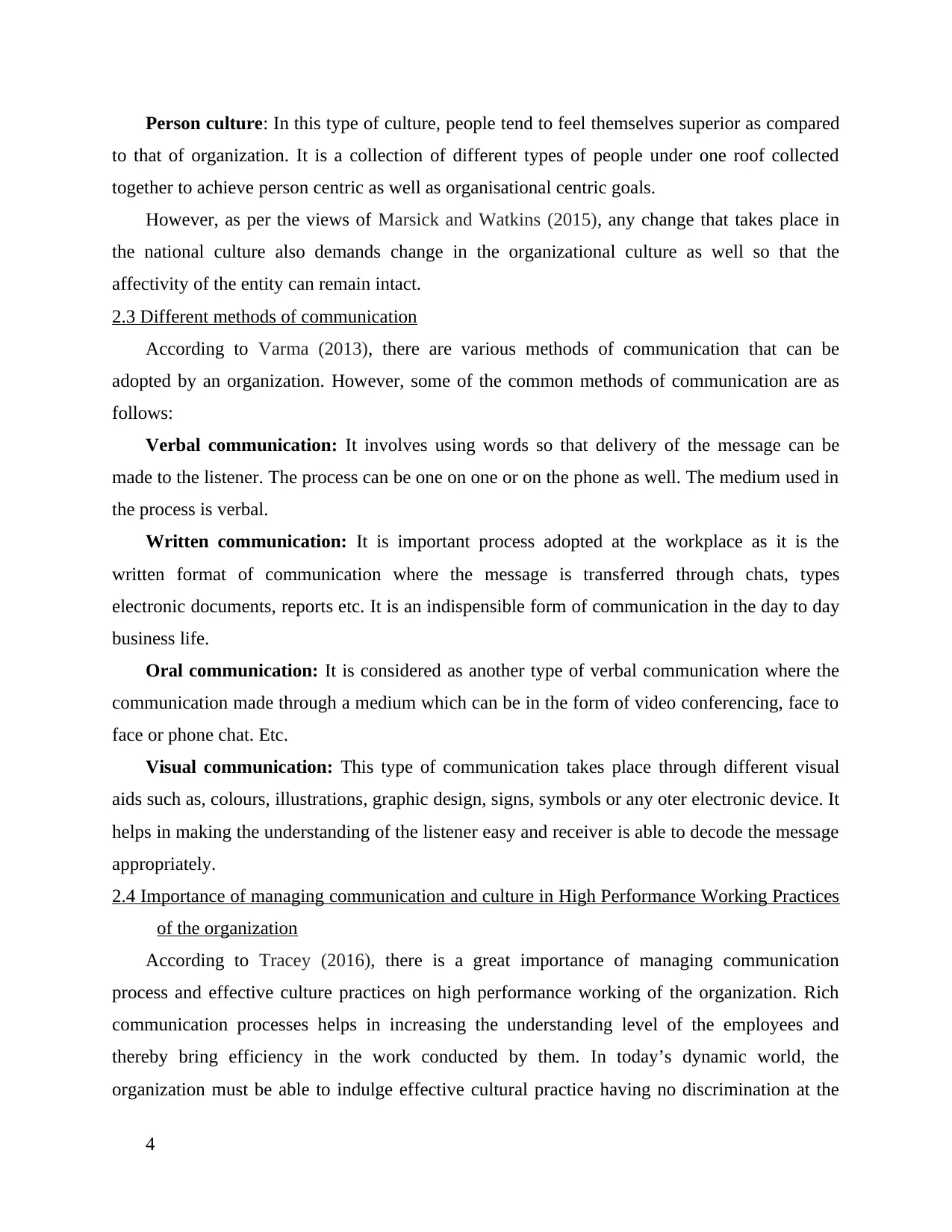
Person culture: In this type of culture, people tend to feel themselves superior as compared
to that of organization. It is a collection of different types of people under one roof collected
together to achieve person centric as well as organisational centric goals.
However, as per the views of Marsick and Watkins (2015), any change that takes place in
the national culture also demands change in the organizational culture as well so that the
affectivity of the entity can remain intact.
2.3 Different methods of communication
According to Varma (2013), there are various methods of communication that can be
adopted by an organization. However, some of the common methods of communication are as
follows:
Verbal communication: It involves using words so that delivery of the message can be
made to the listener. The process can be one on one or on the phone as well. The medium used in
the process is verbal.
Written communication: It is important process adopted at the workplace as it is the
written format of communication where the message is transferred through chats, types
electronic documents, reports etc. It is an indispensible form of communication in the day to day
business life.
Oral communication: It is considered as another type of verbal communication where the
communication made through a medium which can be in the form of video conferencing, face to
face or phone chat. Etc.
Visual communication: This type of communication takes place through different visual
aids such as, colours, illustrations, graphic design, signs, symbols or any oter electronic device. It
helps in making the understanding of the listener easy and receiver is able to decode the message
appropriately.
2.4 Importance of managing communication and culture in High Performance Working Practices
of the organization
According to Tracey (2016), there is a great importance of managing communication
process and effective culture practices on high performance working of the organization. Rich
communication processes helps in increasing the understanding level of the employees and
thereby bring efficiency in the work conducted by them. In today’s dynamic world, the
organization must be able to indulge effective cultural practice having no discrimination at the
4
to that of organization. It is a collection of different types of people under one roof collected
together to achieve person centric as well as organisational centric goals.
However, as per the views of Marsick and Watkins (2015), any change that takes place in
the national culture also demands change in the organizational culture as well so that the
affectivity of the entity can remain intact.
2.3 Different methods of communication
According to Varma (2013), there are various methods of communication that can be
adopted by an organization. However, some of the common methods of communication are as
follows:
Verbal communication: It involves using words so that delivery of the message can be
made to the listener. The process can be one on one or on the phone as well. The medium used in
the process is verbal.
Written communication: It is important process adopted at the workplace as it is the
written format of communication where the message is transferred through chats, types
electronic documents, reports etc. It is an indispensible form of communication in the day to day
business life.
Oral communication: It is considered as another type of verbal communication where the
communication made through a medium which can be in the form of video conferencing, face to
face or phone chat. Etc.
Visual communication: This type of communication takes place through different visual
aids such as, colours, illustrations, graphic design, signs, symbols or any oter electronic device. It
helps in making the understanding of the listener easy and receiver is able to decode the message
appropriately.
2.4 Importance of managing communication and culture in High Performance Working Practices
of the organization
According to Tracey (2016), there is a great importance of managing communication
process and effective culture practices on high performance working of the organization. Rich
communication processes helps in increasing the understanding level of the employees and
thereby bring efficiency in the work conducted by them. In today’s dynamic world, the
organization must be able to indulge effective cultural practice having no discrimination at the
4
⊘ This is a preview!⊘
Do you want full access?
Subscribe today to unlock all pages.

Trusted by 1+ million students worldwide
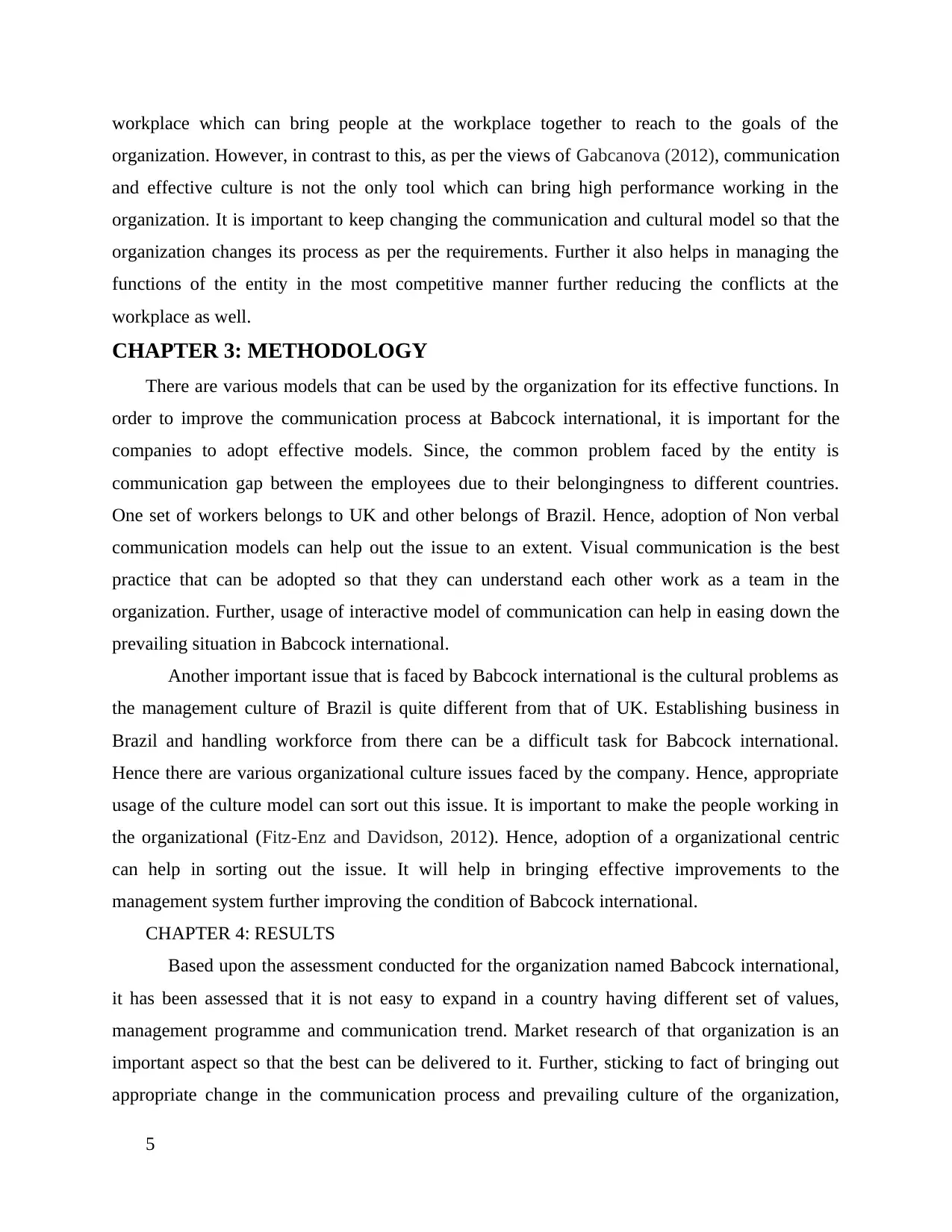
workplace which can bring people at the workplace together to reach to the goals of the
organization. However, in contrast to this, as per the views of Gabcanova (2012), communication
and effective culture is not the only tool which can bring high performance working in the
organization. It is important to keep changing the communication and cultural model so that the
organization changes its process as per the requirements. Further it also helps in managing the
functions of the entity in the most competitive manner further reducing the conflicts at the
workplace as well.
CHAPTER 3: METHODOLOGY
There are various models that can be used by the organization for its effective functions. In
order to improve the communication process at Babcock international, it is important for the
companies to adopt effective models. Since, the common problem faced by the entity is
communication gap between the employees due to their belongingness to different countries.
One set of workers belongs to UK and other belongs of Brazil. Hence, adoption of Non verbal
communication models can help out the issue to an extent. Visual communication is the best
practice that can be adopted so that they can understand each other work as a team in the
organization. Further, usage of interactive model of communication can help in easing down the
prevailing situation in Babcock international.
Another important issue that is faced by Babcock international is the cultural problems as
the management culture of Brazil is quite different from that of UK. Establishing business in
Brazil and handling workforce from there can be a difficult task for Babcock international.
Hence there are various organizational culture issues faced by the company. Hence, appropriate
usage of the culture model can sort out this issue. It is important to make the people working in
the organizational (Fitz-Enz and Davidson, 2012). Hence, adoption of a organizational centric
can help in sorting out the issue. It will help in bringing effective improvements to the
management system further improving the condition of Babcock international.
CHAPTER 4: RESULTS
Based upon the assessment conducted for the organization named Babcock international,
it has been assessed that it is not easy to expand in a country having different set of values,
management programme and communication trend. Market research of that organization is an
important aspect so that the best can be delivered to it. Further, sticking to fact of bringing out
appropriate change in the communication process and prevailing culture of the organization,
5
organization. However, in contrast to this, as per the views of Gabcanova (2012), communication
and effective culture is not the only tool which can bring high performance working in the
organization. It is important to keep changing the communication and cultural model so that the
organization changes its process as per the requirements. Further it also helps in managing the
functions of the entity in the most competitive manner further reducing the conflicts at the
workplace as well.
CHAPTER 3: METHODOLOGY
There are various models that can be used by the organization for its effective functions. In
order to improve the communication process at Babcock international, it is important for the
companies to adopt effective models. Since, the common problem faced by the entity is
communication gap between the employees due to their belongingness to different countries.
One set of workers belongs to UK and other belongs of Brazil. Hence, adoption of Non verbal
communication models can help out the issue to an extent. Visual communication is the best
practice that can be adopted so that they can understand each other work as a team in the
organization. Further, usage of interactive model of communication can help in easing down the
prevailing situation in Babcock international.
Another important issue that is faced by Babcock international is the cultural problems as
the management culture of Brazil is quite different from that of UK. Establishing business in
Brazil and handling workforce from there can be a difficult task for Babcock international.
Hence there are various organizational culture issues faced by the company. Hence, appropriate
usage of the culture model can sort out this issue. It is important to make the people working in
the organizational (Fitz-Enz and Davidson, 2012). Hence, adoption of a organizational centric
can help in sorting out the issue. It will help in bringing effective improvements to the
management system further improving the condition of Babcock international.
CHAPTER 4: RESULTS
Based upon the assessment conducted for the organization named Babcock international,
it has been assessed that it is not easy to expand in a country having different set of values,
management programme and communication trend. Market research of that organization is an
important aspect so that the best can be delivered to it. Further, sticking to fact of bringing out
appropriate change in the communication process and prevailing culture of the organization,
5
Paraphrase This Document
Need a fresh take? Get an instant paraphrase of this document with our AI Paraphraser
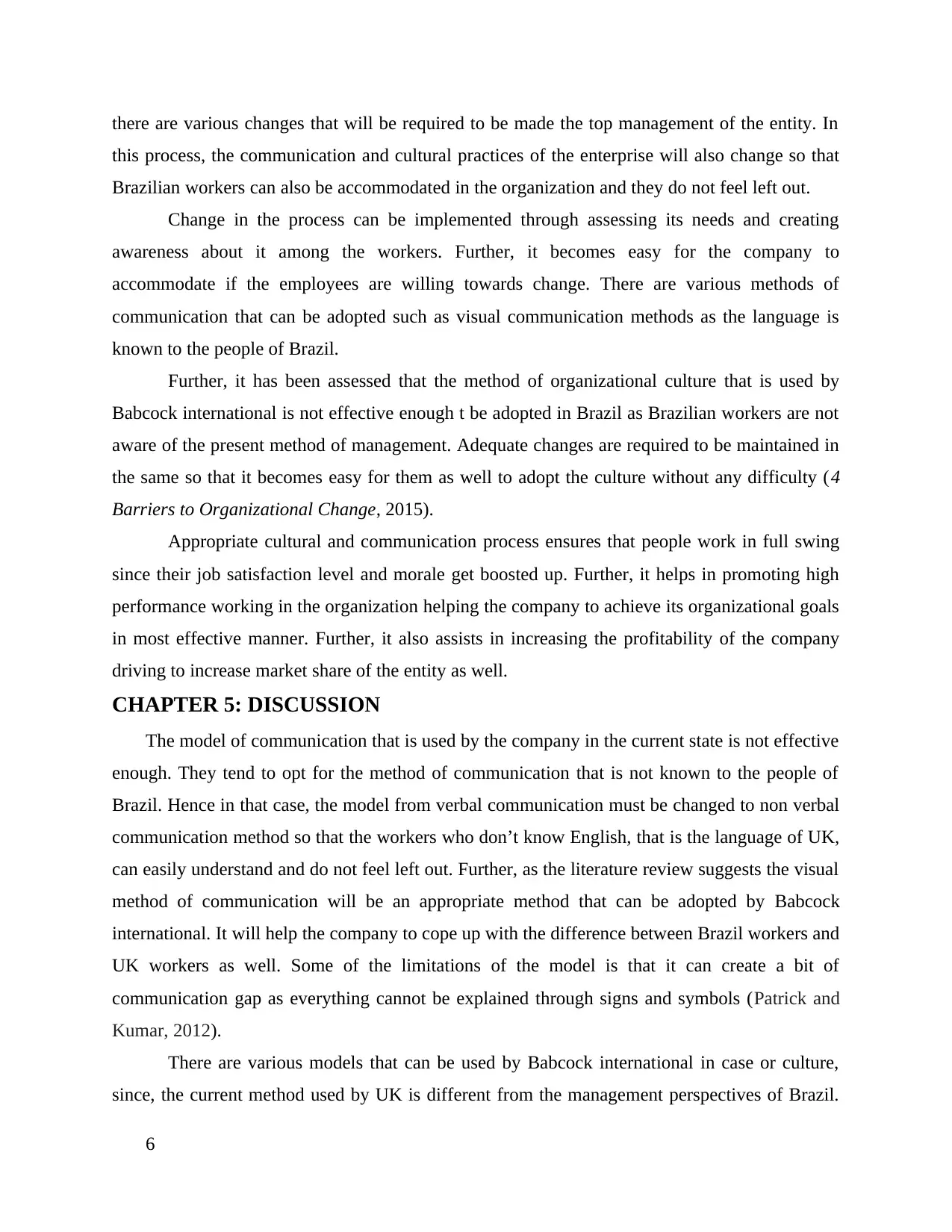
there are various changes that will be required to be made the top management of the entity. In
this process, the communication and cultural practices of the enterprise will also change so that
Brazilian workers can also be accommodated in the organization and they do not feel left out.
Change in the process can be implemented through assessing its needs and creating
awareness about it among the workers. Further, it becomes easy for the company to
accommodate if the employees are willing towards change. There are various methods of
communication that can be adopted such as visual communication methods as the language is
known to the people of Brazil.
Further, it has been assessed that the method of organizational culture that is used by
Babcock international is not effective enough t be adopted in Brazil as Brazilian workers are not
aware of the present method of management. Adequate changes are required to be maintained in
the same so that it becomes easy for them as well to adopt the culture without any difficulty (4
Barriers to Organizational Change, 2015).
Appropriate cultural and communication process ensures that people work in full swing
since their job satisfaction level and morale get boosted up. Further, it helps in promoting high
performance working in the organization helping the company to achieve its organizational goals
in most effective manner. Further, it also assists in increasing the profitability of the company
driving to increase market share of the entity as well.
CHAPTER 5: DISCUSSION
The model of communication that is used by the company in the current state is not effective
enough. They tend to opt for the method of communication that is not known to the people of
Brazil. Hence in that case, the model from verbal communication must be changed to non verbal
communication method so that the workers who don’t know English, that is the language of UK,
can easily understand and do not feel left out. Further, as the literature review suggests the visual
method of communication will be an appropriate method that can be adopted by Babcock
international. It will help the company to cope up with the difference between Brazil workers and
UK workers as well. Some of the limitations of the model is that it can create a bit of
communication gap as everything cannot be explained through signs and symbols (Patrick and
Kumar, 2012).
There are various models that can be used by Babcock international in case or culture,
since, the current method used by UK is different from the management perspectives of Brazil.
6
this process, the communication and cultural practices of the enterprise will also change so that
Brazilian workers can also be accommodated in the organization and they do not feel left out.
Change in the process can be implemented through assessing its needs and creating
awareness about it among the workers. Further, it becomes easy for the company to
accommodate if the employees are willing towards change. There are various methods of
communication that can be adopted such as visual communication methods as the language is
known to the people of Brazil.
Further, it has been assessed that the method of organizational culture that is used by
Babcock international is not effective enough t be adopted in Brazil as Brazilian workers are not
aware of the present method of management. Adequate changes are required to be maintained in
the same so that it becomes easy for them as well to adopt the culture without any difficulty (4
Barriers to Organizational Change, 2015).
Appropriate cultural and communication process ensures that people work in full swing
since their job satisfaction level and morale get boosted up. Further, it helps in promoting high
performance working in the organization helping the company to achieve its organizational goals
in most effective manner. Further, it also assists in increasing the profitability of the company
driving to increase market share of the entity as well.
CHAPTER 5: DISCUSSION
The model of communication that is used by the company in the current state is not effective
enough. They tend to opt for the method of communication that is not known to the people of
Brazil. Hence in that case, the model from verbal communication must be changed to non verbal
communication method so that the workers who don’t know English, that is the language of UK,
can easily understand and do not feel left out. Further, as the literature review suggests the visual
method of communication will be an appropriate method that can be adopted by Babcock
international. It will help the company to cope up with the difference between Brazil workers and
UK workers as well. Some of the limitations of the model is that it can create a bit of
communication gap as everything cannot be explained through signs and symbols (Patrick and
Kumar, 2012).
There are various models that can be used by Babcock international in case or culture,
since, the current method used by UK is different from the management perspectives of Brazil.
6
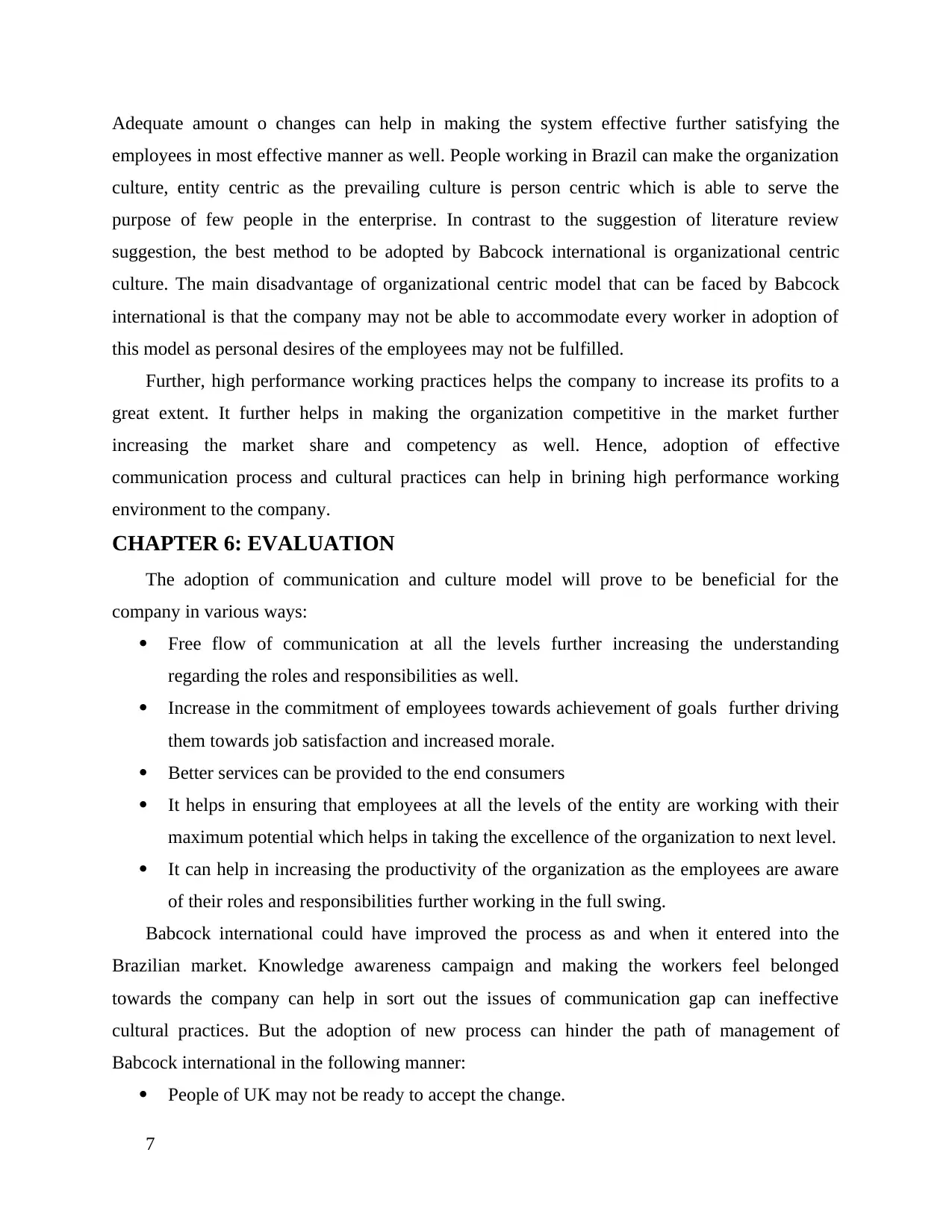
Adequate amount o changes can help in making the system effective further satisfying the
employees in most effective manner as well. People working in Brazil can make the organization
culture, entity centric as the prevailing culture is person centric which is able to serve the
purpose of few people in the enterprise. In contrast to the suggestion of literature review
suggestion, the best method to be adopted by Babcock international is organizational centric
culture. The main disadvantage of organizational centric model that can be faced by Babcock
international is that the company may not be able to accommodate every worker in adoption of
this model as personal desires of the employees may not be fulfilled.
Further, high performance working practices helps the company to increase its profits to a
great extent. It further helps in making the organization competitive in the market further
increasing the market share and competency as well. Hence, adoption of effective
communication process and cultural practices can help in brining high performance working
environment to the company.
CHAPTER 6: EVALUATION
The adoption of communication and culture model will prove to be beneficial for the
company in various ways:
Free flow of communication at all the levels further increasing the understanding
regarding the roles and responsibilities as well.
Increase in the commitment of employees towards achievement of goals further driving
them towards job satisfaction and increased morale.
Better services can be provided to the end consumers
It helps in ensuring that employees at all the levels of the entity are working with their
maximum potential which helps in taking the excellence of the organization to next level.
It can help in increasing the productivity of the organization as the employees are aware
of their roles and responsibilities further working in the full swing.
Babcock international could have improved the process as and when it entered into the
Brazilian market. Knowledge awareness campaign and making the workers feel belonged
towards the company can help in sort out the issues of communication gap can ineffective
cultural practices. But the adoption of new process can hinder the path of management of
Babcock international in the following manner:
People of UK may not be ready to accept the change.
7
employees in most effective manner as well. People working in Brazil can make the organization
culture, entity centric as the prevailing culture is person centric which is able to serve the
purpose of few people in the enterprise. In contrast to the suggestion of literature review
suggestion, the best method to be adopted by Babcock international is organizational centric
culture. The main disadvantage of organizational centric model that can be faced by Babcock
international is that the company may not be able to accommodate every worker in adoption of
this model as personal desires of the employees may not be fulfilled.
Further, high performance working practices helps the company to increase its profits to a
great extent. It further helps in making the organization competitive in the market further
increasing the market share and competency as well. Hence, adoption of effective
communication process and cultural practices can help in brining high performance working
environment to the company.
CHAPTER 6: EVALUATION
The adoption of communication and culture model will prove to be beneficial for the
company in various ways:
Free flow of communication at all the levels further increasing the understanding
regarding the roles and responsibilities as well.
Increase in the commitment of employees towards achievement of goals further driving
them towards job satisfaction and increased morale.
Better services can be provided to the end consumers
It helps in ensuring that employees at all the levels of the entity are working with their
maximum potential which helps in taking the excellence of the organization to next level.
It can help in increasing the productivity of the organization as the employees are aware
of their roles and responsibilities further working in the full swing.
Babcock international could have improved the process as and when it entered into the
Brazilian market. Knowledge awareness campaign and making the workers feel belonged
towards the company can help in sort out the issues of communication gap can ineffective
cultural practices. But the adoption of new process can hinder the path of management of
Babcock international in the following manner:
People of UK may not be ready to accept the change.
7
⊘ This is a preview!⊘
Do you want full access?
Subscribe today to unlock all pages.

Trusted by 1+ million students worldwide
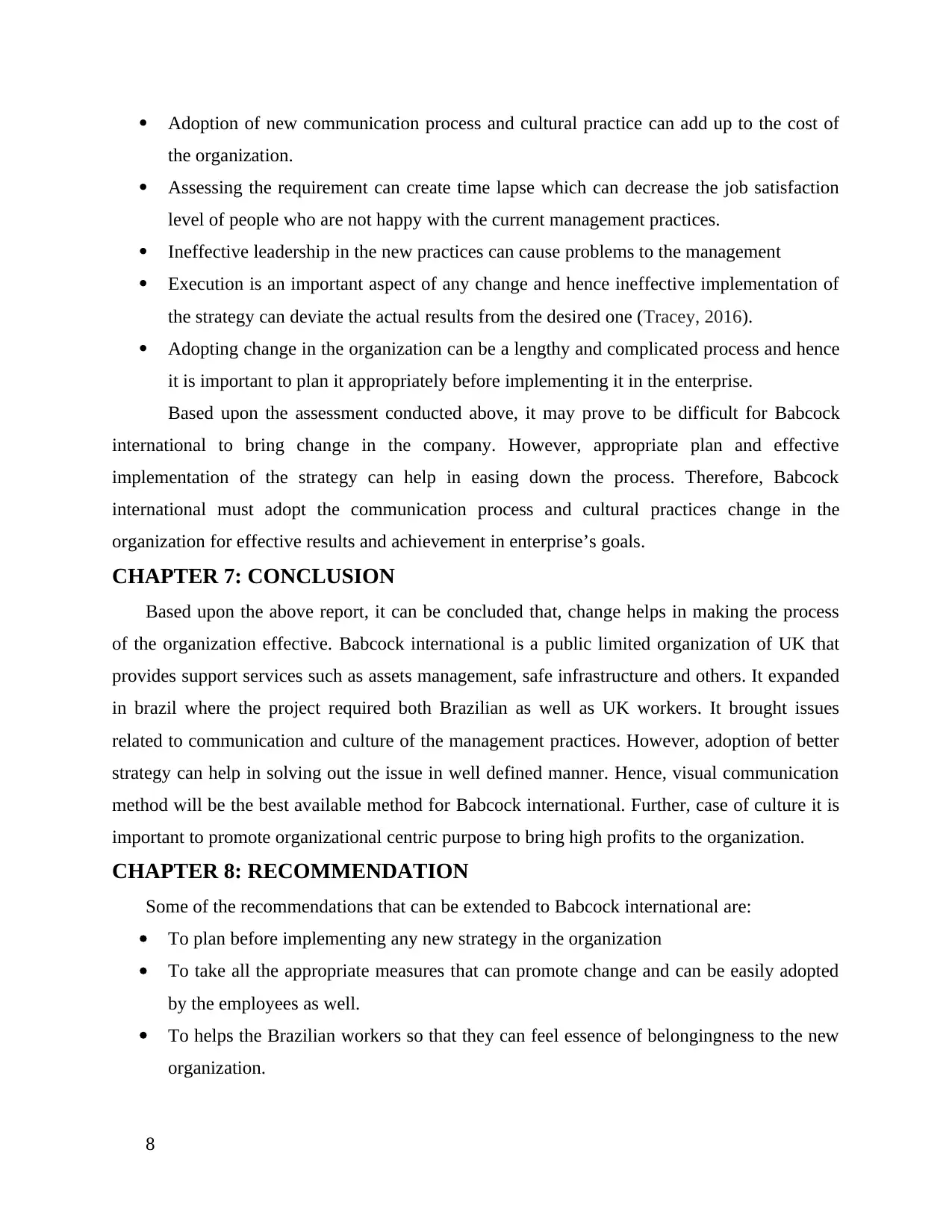
Adoption of new communication process and cultural practice can add up to the cost of
the organization.
Assessing the requirement can create time lapse which can decrease the job satisfaction
level of people who are not happy with the current management practices.
Ineffective leadership in the new practices can cause problems to the management
Execution is an important aspect of any change and hence ineffective implementation of
the strategy can deviate the actual results from the desired one (Tracey, 2016).
Adopting change in the organization can be a lengthy and complicated process and hence
it is important to plan it appropriately before implementing it in the enterprise.
Based upon the assessment conducted above, it may prove to be difficult for Babcock
international to bring change in the company. However, appropriate plan and effective
implementation of the strategy can help in easing down the process. Therefore, Babcock
international must adopt the communication process and cultural practices change in the
organization for effective results and achievement in enterprise’s goals.
CHAPTER 7: CONCLUSION
Based upon the above report, it can be concluded that, change helps in making the process
of the organization effective. Babcock international is a public limited organization of UK that
provides support services such as assets management, safe infrastructure and others. It expanded
in brazil where the project required both Brazilian as well as UK workers. It brought issues
related to communication and culture of the management practices. However, adoption of better
strategy can help in solving out the issue in well defined manner. Hence, visual communication
method will be the best available method for Babcock international. Further, case of culture it is
important to promote organizational centric purpose to bring high profits to the organization.
CHAPTER 8: RECOMMENDATION
Some of the recommendations that can be extended to Babcock international are:
To plan before implementing any new strategy in the organization
To take all the appropriate measures that can promote change and can be easily adopted
by the employees as well.
To helps the Brazilian workers so that they can feel essence of belongingness to the new
organization.
8
the organization.
Assessing the requirement can create time lapse which can decrease the job satisfaction
level of people who are not happy with the current management practices.
Ineffective leadership in the new practices can cause problems to the management
Execution is an important aspect of any change and hence ineffective implementation of
the strategy can deviate the actual results from the desired one (Tracey, 2016).
Adopting change in the organization can be a lengthy and complicated process and hence
it is important to plan it appropriately before implementing it in the enterprise.
Based upon the assessment conducted above, it may prove to be difficult for Babcock
international to bring change in the company. However, appropriate plan and effective
implementation of the strategy can help in easing down the process. Therefore, Babcock
international must adopt the communication process and cultural practices change in the
organization for effective results and achievement in enterprise’s goals.
CHAPTER 7: CONCLUSION
Based upon the above report, it can be concluded that, change helps in making the process
of the organization effective. Babcock international is a public limited organization of UK that
provides support services such as assets management, safe infrastructure and others. It expanded
in brazil where the project required both Brazilian as well as UK workers. It brought issues
related to communication and culture of the management practices. However, adoption of better
strategy can help in solving out the issue in well defined manner. Hence, visual communication
method will be the best available method for Babcock international. Further, case of culture it is
important to promote organizational centric purpose to bring high profits to the organization.
CHAPTER 8: RECOMMENDATION
Some of the recommendations that can be extended to Babcock international are:
To plan before implementing any new strategy in the organization
To take all the appropriate measures that can promote change and can be easily adopted
by the employees as well.
To helps the Brazilian workers so that they can feel essence of belongingness to the new
organization.
8
Paraphrase This Document
Need a fresh take? Get an instant paraphrase of this document with our AI Paraphraser
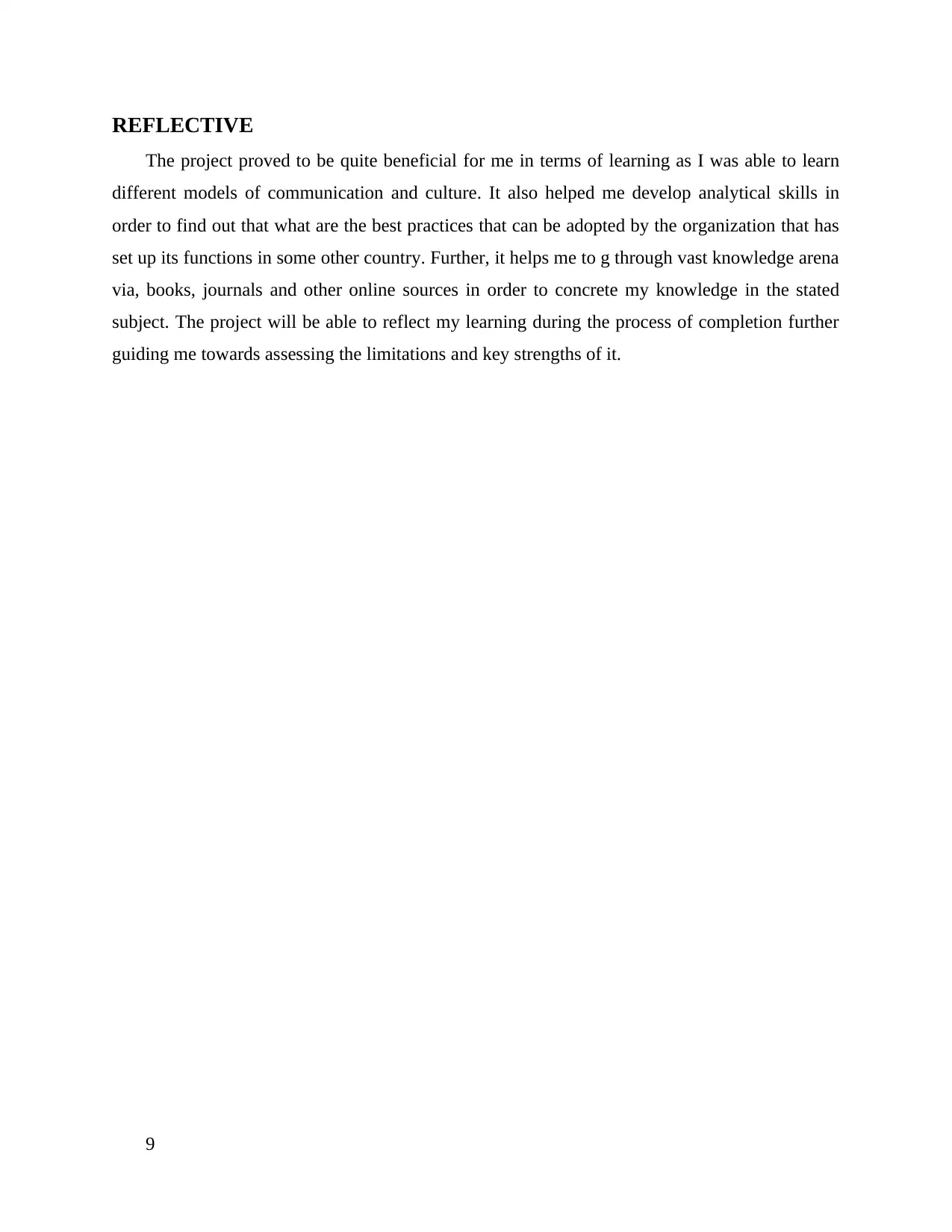
REFLECTIVE
The project proved to be quite beneficial for me in terms of learning as I was able to learn
different models of communication and culture. It also helped me develop analytical skills in
order to find out that what are the best practices that can be adopted by the organization that has
set up its functions in some other country. Further, it helps me to g through vast knowledge arena
via, books, journals and other online sources in order to concrete my knowledge in the stated
subject. The project will be able to reflect my learning during the process of completion further
guiding me towards assessing the limitations and key strengths of it.
9
The project proved to be quite beneficial for me in terms of learning as I was able to learn
different models of communication and culture. It also helped me develop analytical skills in
order to find out that what are the best practices that can be adopted by the organization that has
set up its functions in some other country. Further, it helps me to g through vast knowledge arena
via, books, journals and other online sources in order to concrete my knowledge in the stated
subject. The project will be able to reflect my learning during the process of completion further
guiding me towards assessing the limitations and key strengths of it.
9
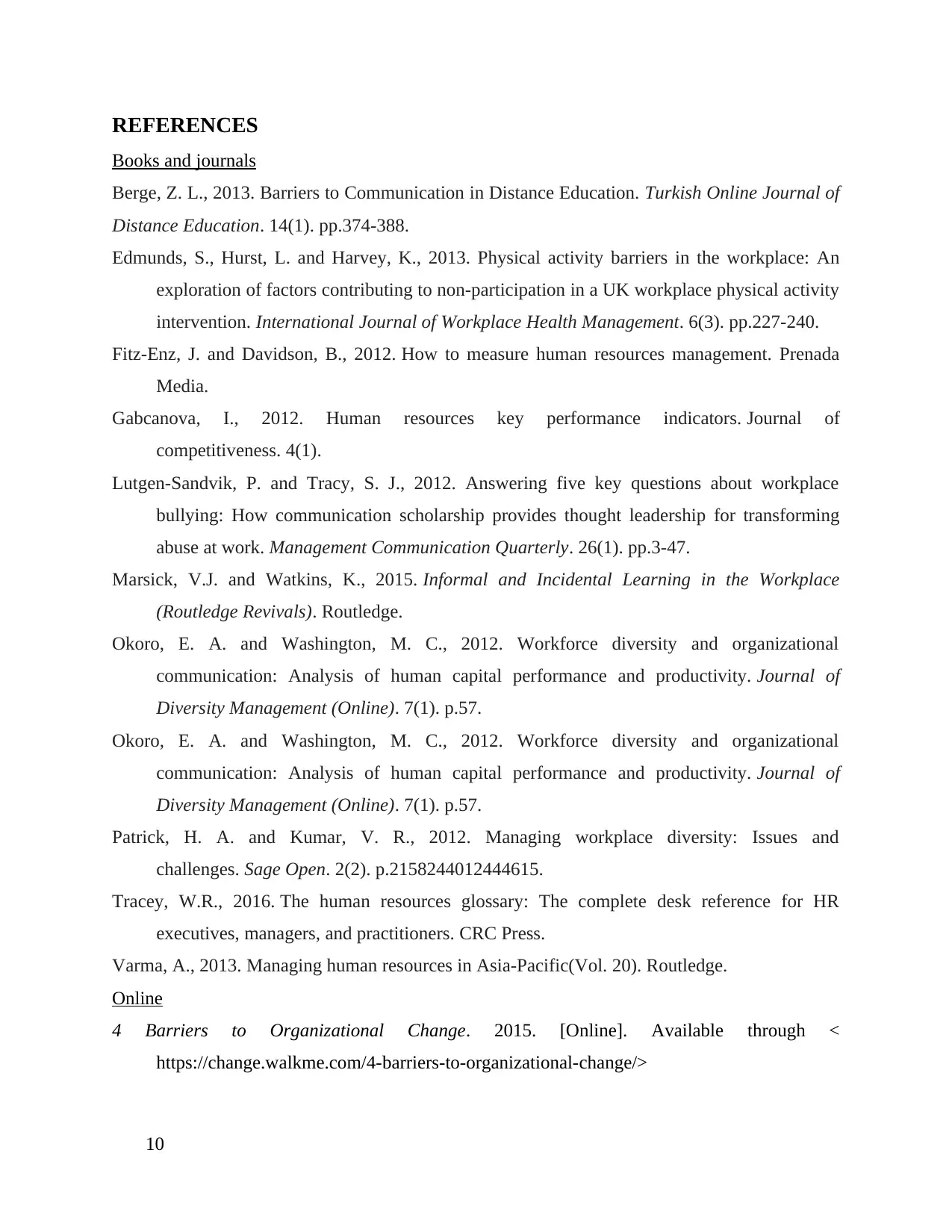
REFERENCES
Books and journals
Berge, Z. L., 2013. Barriers to Communication in Distance Education. Turkish Online Journal of
Distance Education. 14(1). pp.374-388.
Edmunds, S., Hurst, L. and Harvey, K., 2013. Physical activity barriers in the workplace: An
exploration of factors contributing to non-participation in a UK workplace physical activity
intervention. International Journal of Workplace Health Management. 6(3). pp.227-240.
Fitz-Enz, J. and Davidson, B., 2012. How to measure human resources management. Prenada
Media.
Gabcanova, I., 2012. Human resources key performance indicators. Journal of
competitiveness. 4(1).
Lutgen-Sandvik, P. and Tracy, S. J., 2012. Answering five key questions about workplace
bullying: How communication scholarship provides thought leadership for transforming
abuse at work. Management Communication Quarterly. 26(1). pp.3-47.
Marsick, V.J. and Watkins, K., 2015. Informal and Incidental Learning in the Workplace
(Routledge Revivals). Routledge.
Okoro, E. A. and Washington, M. C., 2012. Workforce diversity and organizational
communication: Analysis of human capital performance and productivity. Journal of
Diversity Management (Online). 7(1). p.57.
Okoro, E. A. and Washington, M. C., 2012. Workforce diversity and organizational
communication: Analysis of human capital performance and productivity. Journal of
Diversity Management (Online). 7(1). p.57.
Patrick, H. A. and Kumar, V. R., 2012. Managing workplace diversity: Issues and
challenges. Sage Open. 2(2). p.2158244012444615.
Tracey, W.R., 2016. The human resources glossary: The complete desk reference for HR
executives, managers, and practitioners. CRC Press.
Varma, A., 2013. Managing human resources in Asia-Pacific(Vol. 20). Routledge.
Online
4 Barriers to Organizational Change. 2015. [Online]. Available through <
https://change.walkme.com/4-barriers-to-organizational-change/>
10
Books and journals
Berge, Z. L., 2013. Barriers to Communication in Distance Education. Turkish Online Journal of
Distance Education. 14(1). pp.374-388.
Edmunds, S., Hurst, L. and Harvey, K., 2013. Physical activity barriers in the workplace: An
exploration of factors contributing to non-participation in a UK workplace physical activity
intervention. International Journal of Workplace Health Management. 6(3). pp.227-240.
Fitz-Enz, J. and Davidson, B., 2012. How to measure human resources management. Prenada
Media.
Gabcanova, I., 2012. Human resources key performance indicators. Journal of
competitiveness. 4(1).
Lutgen-Sandvik, P. and Tracy, S. J., 2012. Answering five key questions about workplace
bullying: How communication scholarship provides thought leadership for transforming
abuse at work. Management Communication Quarterly. 26(1). pp.3-47.
Marsick, V.J. and Watkins, K., 2015. Informal and Incidental Learning in the Workplace
(Routledge Revivals). Routledge.
Okoro, E. A. and Washington, M. C., 2012. Workforce diversity and organizational
communication: Analysis of human capital performance and productivity. Journal of
Diversity Management (Online). 7(1). p.57.
Okoro, E. A. and Washington, M. C., 2012. Workforce diversity and organizational
communication: Analysis of human capital performance and productivity. Journal of
Diversity Management (Online). 7(1). p.57.
Patrick, H. A. and Kumar, V. R., 2012. Managing workplace diversity: Issues and
challenges. Sage Open. 2(2). p.2158244012444615.
Tracey, W.R., 2016. The human resources glossary: The complete desk reference for HR
executives, managers, and practitioners. CRC Press.
Varma, A., 2013. Managing human resources in Asia-Pacific(Vol. 20). Routledge.
Online
4 Barriers to Organizational Change. 2015. [Online]. Available through <
https://change.walkme.com/4-barriers-to-organizational-change/>
10
⊘ This is a preview!⊘
Do you want full access?
Subscribe today to unlock all pages.

Trusted by 1+ million students worldwide
1 out of 12
Related Documents
Your All-in-One AI-Powered Toolkit for Academic Success.
+13062052269
info@desklib.com
Available 24*7 on WhatsApp / Email
![[object Object]](/_next/static/media/star-bottom.7253800d.svg)
Unlock your academic potential
Copyright © 2020–2025 A2Z Services. All Rights Reserved. Developed and managed by ZUCOL.




